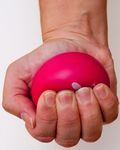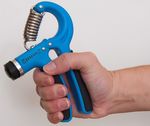Distal Radius (Wrist) Fracture (Adults)
←
→
Page content transcription
If your browser does not render page correctly, please read the page content below
Distal Radius (Wrist) Fracture
(Adults)
Author: Physiotherapist
Department: Therapy
Document Number: STHK1146
Version: 1
Review date: 01/12/2021Information for Patients This is a follow-up leaflet to your recent telephone consultation with the fracture care team explaining the ongoing management of your injury. Your case has been reviewed by an Orthopaedic Consultant (Bone Specialist) and a Physiotherapist. You have sustained a fracture to your distal radius (wrist). This is located at the bottom of your forearm, just below your thumb joint. Occasionally you may also have a small chip fracture at the top of your ulna, which is the other wrist bone that sits below the line of your little finger. This normally takes six - eight weeks to heal. Typically you will have a below-elbow cast on for 5-6 weeks. During this period, you may use the injured hand for light tasks and you should move your wrist and fingers within your pain tolerances straight away. It is important that you follow the rehabilitation plan on the following page to prevent your wrist from becoming stiff and to improve your function. It is advisable to take your pain killers as prescribed to enable you to complete your exercises. You should avoid heavy tasks with your injured hand for six weeks. You can return to driving once your cast and splint have been removed and you feel confident in safely controlling your vehicle. It is common for the wrist to ache and sometimes be painful for a further 3-6 months after your injury, particularly during and after heavy tasks. Please see the picture below to understand where this injury is. If you are worried that you are unable to follow this rehabilitation plan, are experiencing pain or symptoms other than at the site of the original injury or surrounding area, or have any questions, then please contact us for advice using the contact details on the back of this booklet. Smoking cessation Medical evidence suggests that smoking prolongs fracture healing time. In extreme cases it can stop healing altogether. It is important that you consider this information with relation to your recent injury. Stopping smoking during the healing phase of your fracture will help ensure optimal recovery from this injury. For advice on smoking cessation and local support available, please refer to the following website: http://smokefree.nhs.uk or discuss this with your GP. Page 1
Management / Rehabilitation Plan
Weeks since Injury Rehabilitation Plan
0-5 You will have a cast on your wrist.
If you are provided with a sling, continue to use this
for a few days if your arm is painful.
Move your fingers regularly.
You can use your arm for light tasks as pain permits.
Complete stage one exercises
5-12 The cast is usually removed at 5-6 weeks.
Your wrist fracture should be largely united (healed).
You may be provided with a splint. Try to only use
this for the first week after your cast is removed.
Gradually resume normal activities as pain allows.
Heavier tasks or sporting activity may still cause
discomfort.
Complete stage two exercises
12+ Symptoms will continue to improve over the next few
months.
If you are still experiencing significant pain and / or
stiffness please contact us for further advice /
management.
Page 2Exercises Stage 1 Exercises (3-4 times a day) Finger and wrist flexion and extension Open and close your hand of your injured arm as shown 10 times. Then move your wrist up and down 10 times. Elbow bend & straighten Bend and straighten the elbow (of your injured hand) so you feel a mild to moderate stretch. You can use your other arm to assist if necessary, but do not push if it causes pain. Repeat 10 times. Forearm rotations Rest the elbow of your injured arm by your side. Bend it to 90 degrees. Slowly rotate your palm up and down until you feel a mild to moderate stretch. You can use your other arm to assist if necessary. Do not push if it causes pain. Repeat 10 times. Advice Cold packs: A cold pack (ice pack or frozen peas wrapped in a damp towel) can provide short-term pain relief. Apply this to the sore area for up to 15 minutes every few hours, ensuring the ice is never in direct contact with the skin. Page 3
Exercises Stage 2 Exercises (3-4 times a day) Wrist flexion stretch Support your forearm on a table with your hand over the edge and palm facing down. Let gravity take your hand down and then gently apply downwards pressure with your other hand. Hold for 5 seconds. Repeat 10 times. Wrist extension stretch (prayer exercise) Place your palms together in front of you and lift your forearms horizontally. Push your palms together and hold for 5 seconds. Repeat 10 times. Sideways wrist stretches Place your palm on a table and pivot your hand from side to side, making sure that your hand moves in the direction of your thumb and then towards your little finger. Repeat 10 times. Page 4
Exercises
Stage 2 Exercises continued (3-4 times a day)
Grip strength exercises
Regularly squeeze a stress ball for 30-60
seconds
Or
Regularly use hand-held grip strength
equipment
Or
Practice wringing out a damp cloth.
Repeat 10 times
Thumb movements
With your thumb touch each finger-tip
Repeat 10 times.
Whiston Hospital
Warrington Road,
Prescot, Merseyside, L35 5DR
Telephone: 0151 426 1600You can also read



























































